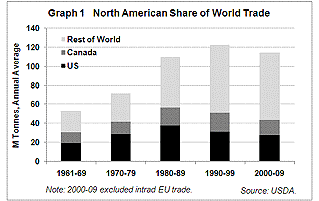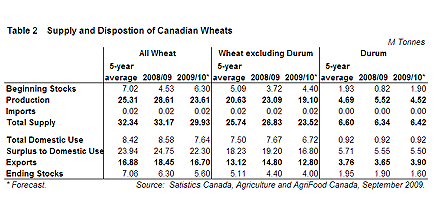
North American Wheat Supply and Demand
- Tuesday September 29, 2009
This analysis featured in the September 29, 2009 issue of the HGCA's MI Prospects, Volume 12, Issue 7
Key Points
Exportable supplies for US wheat are above average, despite production of most classes of wheat below year ago levels. But prospects for reduced Canadian output will likely mean lower exportable supplies.
The influence of the North American wheat supplies on international markets has somewhat diminished over the years, but the US supply situation is still viewed as providing market direction (Graph 1). The US is still holding its position as the largest exporter of wheat despite being only the fourth largest producer. The US has also a relatively open marketing system and unparalleled information and price discovery processes.
continue
US Wheat
Estimates of the US wheat supply 2009/10 are quite precisely known, given that the bulk of US harvest was completed when the most recent (August) estimate of wheat production was made and the survey of carry-over stocks was published. The process of forecasting domestic use and export will continue with USDA's monthly revisions until next spring.
The combination of a smaller crop and lower forecast imports but larger beginning stocks is estimated to raise US domestic wheat supplies 1% compared to 2008/09 to 80.6Mt (Table 1). A small recovery in domestic food consumption is anticipated, projected at a record of 26.0Mt. But consumption has been virtual static over the last 15 years. A relatively high level of feed use is forecast at 6.4Mt, but this is not significant in the context of total US feed grain consumption. Most of the limited feeding of wheat occurs after the Soft Red Winter wheat (SRW) harvest and before the maize harvest and is generally confined to the east coast.
continue
UK wheat has on occasion been imported for this purpose. Total US domestic wheat use is forecast at 34.5Mt, leaving 46.1Mt surplus to domestic consumption needs and available for export and ending stocks. This is the largest surplus to domestic use since 2003/04, but is not at a high level when compared to years prior to that. The USDA is forecasting exports of 25.9Mt, 6% below last year and the lowest level since 2006/07.
The situation varies somewhat for the different classes of wheat. For Hard Red Winter wheat (HRW), yields were down as a result of dry conditions in the southern Great Plains. This offset the increase in carry-over and resulted in supplies remaining largely unchanged from a year earlier. A quality-related increase in anticipated domestic consumption is seen to result in supply surplus to domestic needs of 6% below last year, which would be still at the high end of the recent range.
A substantial reduction in SRW wheat output following a reduced area was partially offset by a larger carry-over. Even factoring in a forecast for reduced domestic consumption, surplus to domestic consumption at 8.3Mt is 19% below last year, but this is still towards the top end of the range of export availability. The market is in essence still working off the exceptional large crop in 2008 which was stimulated by incentive prices in autumn 2007.
White Winter wheat output (grown in the Pacific Northwest and mainly aimed at Pacific markets) has been quite stable in recent years despite general price volatility. With higher opening stocks offsetting a small drop in domestic production, 2009/10 supply is estimated to rise by 8%, but this is still at the low end of the range. USDA forecast a rise in white winter wheat exports and a reduction in ending stocks.
Although the area sown to Hard Red Spring wheats (HRS) in 2009 was lower, yields improved on the good yields of 2008. With production almost matching 2008 and a recovery in stocks, supplies are up 11%. Domestic consumption is seen similar to 2008/09, leaving supply surplus to domestic consumption 21% higher than last season, which would be at the high end of a ten-year range.
Supplies of US durum this year have increased by 24% as a result of record yields and an increase in ending stocks. The USDA predicts, however, that the US will be a net-importer of durum this year, as it has been for two of the last three years.
The major question is, as always, the divide of supply surplus to domestic requirements between exports and ending stocks. The USDA's weekly reports of export sales suggest rather uncertain prospects. Outstanding sales (wheat sold but not shipped) as of 10 September totalled 4.2Mt, 66% of outstanding sales last year at this time and 38% of sales in 2007. These outstanding sales represent just eight weeks of shipments and indicate at best a hand-to-mouth attitude towards buying US wheat. HRW and HRS wheat appear most adversely affected, with outstanding sales just 47 and 56% of year ago levels, while white wheat and durum are ahead of year ago levels. The USDA has appeared reluctant to lower its crop year export projections with this slow pace of export sales just as it was reluctant to raise them when outstanding sales ballooned two years ago.
Canadian Wheat
The first pre-harvest estimate by Statistics Canada of Canadian wheat and durum production is made at the end of July. This, with the results of the August 1 stocks' survey, provides an indication of the Canadian supply situation. As very little of the Canadian crop is harvested at the time of the survey, the accuracy of this Canadian estimate does not match its US contemporaries. This may be more so this year due to the lateness of the Canadian crop. But the estimate provides a good indication of direction.
The projected supply of Canadian wheat for 2009/10, excluding durum, at 23.5Mt, is 12% below last season (Table 2). This is mainly the result of lower yields, estimated 18% below 2008. Agriculture and Agrifood Canada (AAFC) forecast Canadian wheat supply surplus to domestic needs at 16.8Mt, 12% below year ago levels. This is quite low by Canadian standards, but the recent centralization of the Prairie country elevator systems allows for ending stocks to be run down to a much lower level. Exports are projected at 12.8Mt, 14% below year ago levels and ending stocks at 4.0Mt, down 9%.
continue
Canadian durum supplies are estimated at 6.4Mt, 1% above last year. Production is estimated 18% lower as a result of a lower area and reduced yields. AAFC forecast exports to increase by 7% to 3.9Mt and ending stock to decline by 16% to 1.6Mt. Export availability of 5.5Mt is mid-range given recent Canadian durum supplies.
Very favourable harvest weather during September will undoubtedly result in improved quality in terms of grade but not for protein. It may not do as much for yields. Canadian wheat supplies, and particularly higher protein Hard Red Spring wheats, will not be abundant this year.
David Walker (001) 780 434 7615
top of page